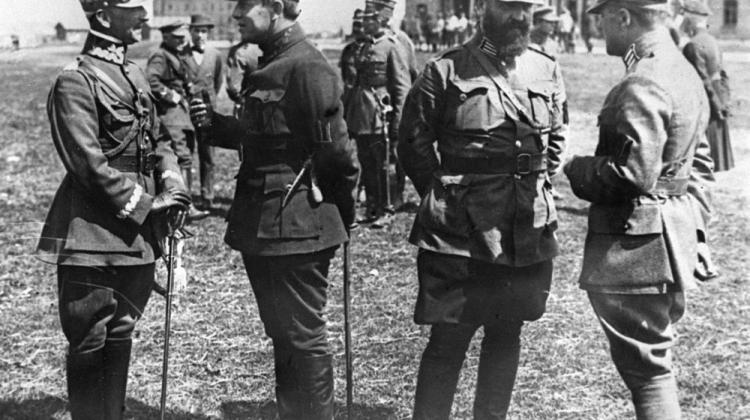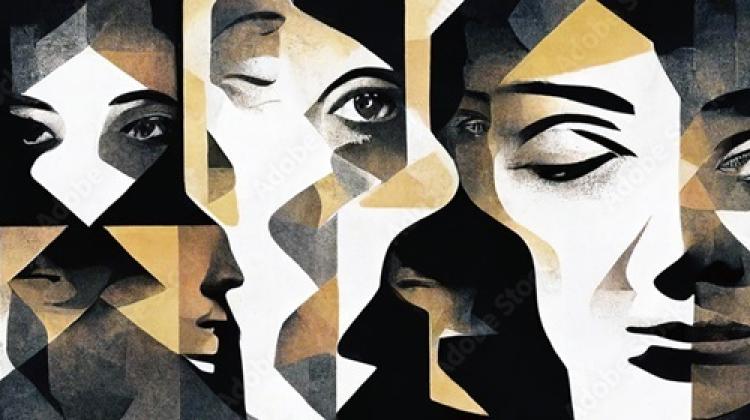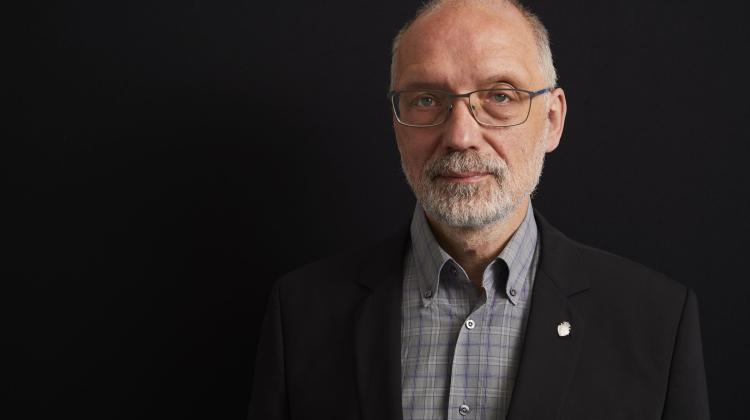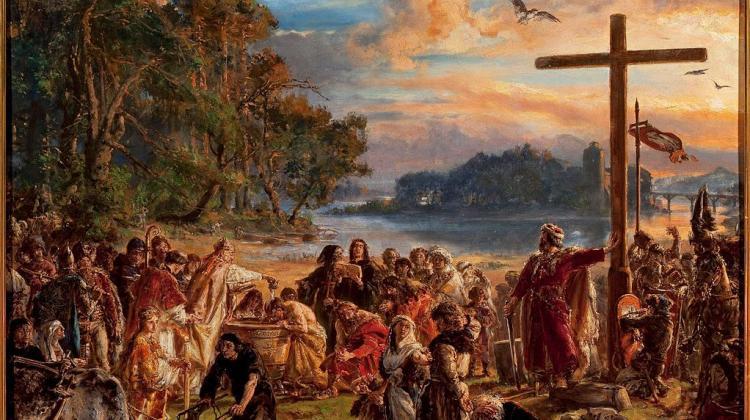Dr. Piotr Kroll: The history of Poland and the history of Ukraine were often intertwined
 Kiev expedition: Commander of the Ukrainian People's Republic army, Symon Vasylyovych Petliura (2L) and Polish General Antoni Listowski (L) among Polish soldiers, 04.1920. Photo PAP/CAF/Archive
Kiev expedition: Commander of the Ukrainian People's Republic army, Symon Vasylyovych Petliura (2L) and Polish General Antoni Listowski (L) among Polish soldiers, 04.1920. Photo PAP/CAF/Archive
The history of Poland and the history of Ukraine were often intertwined. You could say that Polish-Ukrainian cooperation dates back to the beginnings of our countries, says Dr. Piotr Kroll, a historian from the University of Warsaw.
Polish Press Agency: How far into history do Polish-Ukrainian relations and cooperation between the two countries reach?
Dr. Piotr Kroll: Cooperation between Poland and Ukraine dates back to the beginnings of our statehood, Kievan Rus' and the state of Mieszko I. The two countries were neighbours, which naturally fostered mutual contacts and influences. It can therefore be said that the history of Poland and the history of Ukraine were often intertwined.
Of course, in our common history there were both periods when we cooperated and those when our countries competed or fought. It was inevitable in the context of such close and natural contacts between neighbouring countries. It is enough to mention the most famous examples of the intertwining of friendship and hostility in the period of the struggle of both nations for independence after the end of World War I. First, there was a conflict because of opposing interests - the fight for Lviv and the eastern part of former Galicia, and then cooperation, which was reflected in the agreement between Józef Piłsudski and Semen Petliura, and a joint Polish-Ukrainian fight against Soviet Russia.
PAP: You mentioned the cooperation from the beginnings of the Piast state and Kievan Rus'. What did that cooperation involve?
Dr. Piotr Kroll: There were frequent marriages between the Polish Piasts and the Ruthenian Rurikids, which naturally led to cooperation between the two dynasties. The political plans and interests of individual rulers were the reason for these relationships, but they led to cooperation in the name of related representatives of the other party. In this context, it is enough to mention the interventions of the Polish kings, Bolesław I the Brave and Bolesław II the Generous, on behalf of their Rurik sons-in-law and supporting their efforts to secure the Kiev throne. Of course, one should not think that the Polish rulers did that only out of the goodness of their hearts, but they did count on their actions leading to closer cooperation between the countries and maintaining good-neighbourly relations. Another example of cooperation was the help that the ruler of Ruthenia, Jarosław the Wise, gave Casimir I the Restorer in the mid-11th century in his return to the Polish throne and defeating Miecław, the ruler of Mazovia, who threatened the unity of the Piast state.
This cooperation, based on political calculations and marriages between the Piasts and the Rurikids, continued in the following years. During the period of the fragmentation of Poland, the Piasts actively supported the Romanoviches, one of the branches of the Rurik dynasty, rulers of the Duchy of Halych-Volodymyr. Both dynasties were united by an alliance thanks to which the Romanoviches won the Halych throne. But also in this case, years of cooperation were intertwined with times of rivalry and conflict.
PAP: And what did this cooperation look like in later periods?
Dr. Piotr Kroll: A lot changed in the following centuries. During the reign of Casimir III the Great, parts of the Ruthenian lands were incorporated into the Polish state. In the 16th century, as a result of the incorporation of Volhynia and the Kiev region following the Union of Lublin (1569), the remaining lands of today's Ukraine joined them. Now Ruthenians and Poles found themselves in one country and it is worth emphasizing that they considered it their common homeland. One of the reasons was the tolerant religious policy of Polish and Lithuanian rulers. Thanks to this and the possibility of living freely in Poland and Lithuania, Ruthenians felt they were citizens of equal rights to other nations. They took part in the political life of the country, decided on its policies, elected its rulers. Ruthenian culture and art developed freely, drawing on the achievements of its own tradition and Western culture.
Recognition of Poland, and later the Commonwealth by Ruthenians as their homeland meant that they defended its territory with other nations living in Poland. A good example of this is the battle of Grunwald in 1410. Ruthenian knights and boyars serving under King Władysław II Jagiełło and Grand Duke Vytautas, together with Polish knights and Lithuanian warriors, fought against the most dangerous enemy of Poland and Lithuania - Teutonic Knights and contributed to the victory. A great blood sacrifice way made by the Smolensk Regiments, consisting of Ruthenian boyars and warriors who withstood the Teutonic strike and bravely faced the enemy. In that period, the Principality of Smolensk was considered an integral part of the Kiev Rus' (subordinated to Lithuania), not the Duchy of Moscow.
In the modern era (16th-17th century), the Ruthenian nobility and soldiers from the lands of today's Ukraine defended the country against Tatar raids, and sometimes against the Ottoman Empire, or Turkey. In addition to the nobility and professional soldiers, the Cossacks (Ruthenian peasants and the townspeople) also participated in these activities. They also considered the Commonwealth their homeland and fulfilled the obligation to defend it. Although sometimes their actions caused a threat of war with Turkey.
The best example from that period of common defence is the battle with the Ottoman Empire in 1621. Near Khotyn, the Polish-Lithuanian-Ruthenian army stopped the campaign of the armny of the Ottoman Empire, at the time considered the largest and most powerful empire in the world. Significant contribution was made by the Ruthenian nobility serving in the royal army and the Cossacks. The myth of the common fight in defence of the state and Christian faith was embedded strongly in the minds of the participants of these fights, more strongly binding the Ruthenians, including Cossacks, to the Commonwealth as the common homeland.
PAP: Russia was a dangerous enemy in the history of both Poland and Ukraine.
Dr. Piotr Kroll: From the 15th century and the first confrontation between Lithuania (already in the Union with Poland) with the Grand Duchy of Moscow, Ruthenians - subjects of Lithuanian Jagiellons - participated in these battles. It is worth emphasizing that the cases of betrayal in Ruthenian ranks and defecting to Moscow's side were extremely rare. Ruthenians clearly stood on the Lithuanian side, and later with the Commonwealth. One of the most well-known Ruthenians commanders of the turn of the 16th century, prince Konstanty Ostrogski, when taken captive refused to serve the Duchy of Moscow despite the community of faith and remained loyal to Lithuania and its rulers. In 1514, became the commander in chief of all the Ruthenian, Polish and Lithuanian forces and defeated the Moscow army in the Battle of Orsha in 1514.
There were many more examples of such cooperation. All the nations of the Polish-Lithuanian state fought in its defence against not only Moscow, but also against Swedes or the previously mentioned Ottoman Empire. That was the case during the Stefan Batory wars and numerous conflicts with neighbours during the rule of the Vasa dynasty. Ruthenian nobility and Cossacks fought Moscow during the Time of Troubles (1604-1613), near Smolensk in 1632-1634. Ruthenians remained loyal to the Polish-Lithuanian Commonwealth in the difficult times of the Swedish Deluge and Moscow invasions.
Cossacks who wanted to create their own country in the Ukrainian lands and had made alliances with enemies of the Polish-Lithuanian state, in 1658 signed an accord known as the Treaty of Hadiach - a model of readiness to compromise on the principles of respecting each other's differences. This treaty transformed the Commonwealth into a state of three equal parts - the Crown of Poland, Lithuania and the Duchy of Ruthenia. It was a decision showing on the one hand, the readiness of the Polish side to make concessions, and on the other - the attachment of the Orthodox Cossacks of Ruthenian origin to the common homeland and its political culture. They preferred to be its citizens than subjects of the Moscow Tsar. The fact that the future turned out to be different resulted from a number of coincidences. But the memory of the Treaty of Hadiach remained in the Cossack community.
PAP: Did Poles and Ukrainians cooperate during the partitions?
Dr. Piotr Kroll: The period of partitions was the time of national rebirth of the Ukrainians, the emergence of a modern nation that dreamed of rebuilding its own state. It was similar in the case of Poles. The two nations had common enemies - Russia and Austria, countries that swallowed the lands inhabited by both nations. But the common enemy did not mean cooperation. Poles and Ukrainians had more differences than they had in common. Above all, the attitude towards Ukrainian lands. Poles believed that they should be in the reborn Poland, and denied the Ukrainians' right to self-governance. It was an extremely difficult period for all, because the conflict between both nations was fuelled by the invaders. In this way, they tried to squash the national aspirations of Poles and Ukrainians. However, there were also those who did not hesitate to support the political aspirations of the other nation, taking part in Polish uprisings or hiding their participants.
PAP: We talked about political and military cooperation. How is this intertwining and Polish-Ukrainian cooperation visible in culture, in intellectual life?
Dr. Piotr Kroll: Despite belonging to different civilizations in the Middle Ages - Poland to Western, and Rus' to Eastern civilization - due to the close neighbourhood and maintained political and commercial relations, the two countries influenced each other also in this regard. Polish and Ruthenian cultures intertwined, especially close to the border, in Halych Rus' and in Lesser Poland. The Western culture was undoubtedly more attractive and more strongly affected Ruthenians. It was especially evident the incorporation of Halych Rus', and later the other lands of today's Ukraine into Poland. But in Polish lands there are also examples of Ruthenian influences in art and architecture, like the Trinity Chapel in the Lublin castle.
The influence of Polish and Western Culture on Rus' has become stronger after the Union of Lublin in 1569. The Commonwealth played the role of the Western European culture transmission belt for Ukrainian areas. This can be seen both in the architecture preserved to this day in Western Ukraine (castles, palaces, cities like Lviv) modelled on the Western European art, as well as education. Under the influence of educational solutions developed in the West during the Reformation and Counter-Reformation, the Orthodox Ruthenians began to organize their own education. Schools organized in large urban centres, like the Ostroh Academy or the Mohyla Collegium (its continuator is the National University of Kyiv-Mohyla Academy in Kiev) introduced a curriculum modelled on that of Protestant and Jesuit schools. The purpose of these activities was to educate youth, which would be part of the Commonwealth and the West, and at the same time preserve a sense of belonging to the Orthodox Ruthenian community. Another example of mutual influences is Ruthenian literature, which strongly developed in the times of the Commonwealth (16th-18th century), also under the influence of Polish literature. Political journals were created, as was historical literature describing the past and the modernity of Rus', poetry combining both the Ruthenian, Orthodox and Western influences (an example was Lazar Baranovych, an Eastern Orthodox archbishop and author of poems, which he wrote in Polish despite living outside of the Polish-Lithuanian state in the second half of the 17th century).
A great example of the impact of Polish political culture, is the attachment of the Cossacks to it, even when they were no longer associated with the Commonwealth. Enough to mention a scene in 1654 in Pereyaslav (Pereiaslav Agreement), when the Cossack hetman Bohdan Khmelnytsky pledge allegiance to the Tsar of Russia. According to the Polish–Lithuanian Commonwealth tradition, the Cossacks demanded that the Tsar's representative would make binding declarations on the Tsar's behalf. Another example are the Cossack documents drawn up in the Left-bank Ukraine when it was under the Russian rule. Their style and legal phrases are similar to documents created in the Polish-Lithuanian Commonwealth. This shows how strong the influence of Polish political culture was in the Ruthenian communities, even after they were no longer a part of the Commonwealth.
Another interesting fact is that among the 19th-century Ukrainian historians, the fathers of Ukrainian historiography, there are two descendants of Polish noble families that settled in Ukraine - Volodymyr Antonovych and Vyacheslav Lypynsky. Polish authors also include those who identified with the Ruthenian culture, like Jan Szczęsny Herburt, who considered himself a Ruthenian.
PAP: What could be the areas for future Polish-Ukrainian cooperation?
Dr Piotr Kroll: Further cooperation should of course develop in all areas - political, economic, educational, scientific or cultural. It is our duty to support Ukrainians in their integration with Western Europe and oppose Russian policy based on falsifying history, political actions, economic and military pressure. The Ukrainian nation, with its rich history, culture and tradition, has already proven more than once that it still has strong democratic tendencies dating back to the times of the Commonwealth and is ready to fight for democracy and civil liberties. Remember the Orange Revolution or the Euromaidan. Now, they are defending the integrity and sovereignty of their state. Cooperation will also allow us to deal with those parts of our common history that divide us. I hope that we will reach an agreement in this respect.
As a researcher, I would also like to draw attention to the fact that science opens many areas for cooperation. We should definitely use it. As a historian, I want to say that we still have many common historical problems to explore and explain. These include our cooperation over the centuries, the history and everyday life of the Ukrainian lands in the times of the Commonwealth, the difficult matters related to rebirth of independence movements Ukrainian and Polish in the 19th century and shaping the modern nations, and above all the difficult issues the interwar and World War II period. This requires a lot of work, especially in the case of the recent history, but without cooperation between both scientific communities, the explanation of these issues will not be possible. (PAP)
Interview by Anna Kruszyńska (PAP)
Author: Anna Kruszyńska
akr/ skp/ kap/
tr. RL
Przed dodaniem komentarza prosimy o zapoznanie z Regulaminem forum serwisu Nauka w Polsce.


















